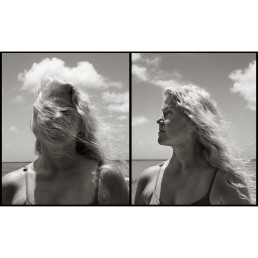S1: Episode 6 - Katie Keim

Episode Information
[Intro Music]
Narrator: Welcome to My Heart is Not Blind. Narrative histories about blindness and perception. A traveling exhibition and book published by Trinity University Press, supported by Gronkowski Charitable Foundation, edited and hosted by Michael Nye. Every person. Every place is a map to somewhere else. Episode six Katie Kime.
Katie: My name is Katie. I live in Honolulu, Hawaii in a beautiful location right on the ocean at the base of Diamond Head Crater. I will say a few of my most favorite Hawaiian words, kolohe, which means mischievous or rascal. Kāna ipo is sweetheart, I actually really like the word kokua. It means for your help in working together. I understand. I was born smiling. It’s a permanent fixture. When I thought I was the most doer or angry, people said, you’re still smiling, I guess how else to be? I’ve tried to frown for long periods of time and my mouth flips back up to a smile.
I was eight years old when diabetes came. The graduation of blindness, the first signs of it didn’t show up until I was 28. At the age of 36, while I was living in Maui, Hawaii, I woke up one morning and I could no longer see, and that’s when blindness for me truly began. I was in first denial, then fury. Far beyond anger. I was in fury. I tore apart my mattress, my bed frame, and I did this by hand. The emotions all came at once. It was as if someone turned the, the headphones on at concert level. Volume, I, I just couldn’t be I, I just, it was so overwhelming. The sounds, the feelings, the sensations, all the ways that my receptors were on wide open, trying to gather data to exist in the world without sight.
In those first few months when I was trying to get through all the muck of blindness, I experienced walking by a large Ponderosa pine tree and hearing that it was next to me through my arm and my skin, not through my ears, not through my eyes. That didn’t work anymore. Not through the smells, but through my skin. I heard it, so things started to come back to me in the realization. I’d always heard them, I’d always felt them, tasted them, touched them, but I’d always thought I’d seen them that I realized I could still see without seeing.
I know that I’m only human, and yet I’ve always strived to be diplomatic. Strangers coming up to me on the street interacting with me. Yet I find it very challenging now that I’m blind to maintain that diplomacy. I have this rule, I call it my 101 rule. If you happen to be the 101 person, in my reality that day, that grabs me, pokes me, asks me how it is to be blind. Are you okay? Are you angry? You’re so amazing. If you’re the 101 person, watch out. I might hurt you <laugh> because I’m so tired of my white cane indicating there’s a difference that you have the license to interact with me in a manner that I find rude and disrespectful, typically. I am highly visual person and always have been. I learn best by doing so. Everything I hear, smell, touch, feel, and senses. We don’t have labels for turns into a vision in my mind without a pause. I meet someone and there’s a vision in my mind’s eye of who they are and what they are and how they look, but it’s not in the finite detail of what an eye can see. It’s more an essence.
It took me approximately seven years almost to the day of losing my vision. I woke up and thought, oh, I’m normal again, and normal’s a funny word, but it’s the only word that describes being back in yourself and feeling comfortable and normal in my skin, again. If I woke up tomorrow and had regained my sight, I would still go about my day using my tools of blindness, walking with my cane out in the public because I know it would be a similar kind of shock in that I have so adjusted to perceiving the world as a blind person that I would have to go through my own rehabilitation back to seeing again. I know of that of myself.
[Outro Music]
Host: This is Michael Nye, and you have been listening to a podcast of narrative histories. Katie calls herself a very big risk taker. She looks for the best ways to create design and aesthetics for the flow and movement in life. She is married to Virgil Stanette, and they both are mentors to many students that are adapting to sight loss. They live in Honolulu, Hawaii, in a glorious spot right on the Pacific Ocean at the base of Diamond Head crater. Katie takes a swim every evening in the ocean. She loves the word gravitation-less a sense of freedom and motion without gravity and saltwater.
Join me next week. Two new episodes will be released. Please subscribe, rate, and review this podcast. You can also go to my website, michaelnye.org/podcasts for transcripts and other information. There are so many ways, different ways to experience moments to their fullest. Thank you for listening.
